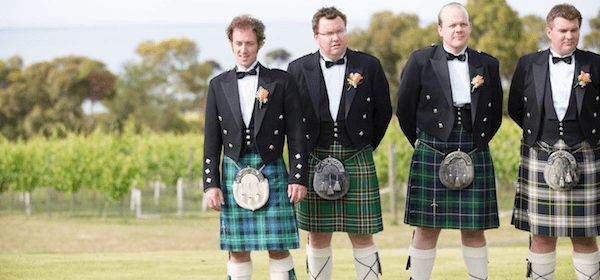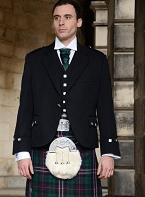Scottish Wedding Traditions

Traditions at a wedding in Scotland go far beyond wearing a kilt. Here we look at the ancient and modern rituals and customs from Scotland, some of which are commonplace and some that are still followed in only a few small areas of Scotland.
Pre-wedding traditions from Scotland
During the engagement, Scottish brooches known as Luckenbooth are given as tokens of love. These are usually made of silver and engraved with two intertwined hearts. If the couple pins the Luckenbooth to the blanket of their first born it is said to bring the family luck.
The bride's female friends wash her feet in a tub. A wedding ring from a happily married woman is placed in the tub and whoever finds it is said to be the next to marry.
The day of the wedding
In Scotland, the 'wedding sark' is the shirt worn by the groom which according to traditions is gifted by the bride. In return, the groom pays for the wedding dress.
In Scotland’s wedding traditions, the bride should leave her house on the way to her wedding leading with the right foot.
A sprig of white heather hidden in the bride's bouquet is another of Scotland’s wedding traditions, particularly in the border region.
The ‘wedding scramble’ is one of the traditions that is continued nationwide. As the bride steps into the car, her father throws a handful of coins for the children to collect. Believed to bring about financial good fortune, and in Ayrshire it is known as a 'warsel'.
Ceremony and reception

Gretna Green’s Famous Blacksmiths Shop is where couples, including countless runaway lovers, have been coming to tie the knot since 1754. Lured by Scotland’s lenient marriage laws, the bride and groom eloped to the sleepy town of Gretna Green on the border between England and Scotland.. Today you can still say your vows over the original anvil used by the ‘Blacksmith Priest’.
The bag pipes or traditional Gaelic hymns are typically played or sang at a wedding ceremony in Scotland. Traditions state the groom wears a kilt, a kilt jacket, and a sporran in his clan colours and the couple participates in a hand fasting ceremony where their wrists are bound together by a cloth or string.
Following the vows the groom often pins a strip of his clan’s tartan colours to the bride’s wedding dress to signify that she is now a member of his clan.
The Wedding Walk is the traditional march taken by the wedding party to the church. Preceded by a piper or fiddler, the bridegroom leads the maid of honour while the bride walks behind with the best man. After the ceremony, the newly-weds leave the church followed by the best man escorted by the maid of honour. To secure good luck it was traditionally thought that the wedding procession should cross running water twice.
A Penny Wedding is an ideal solution for those after a traditional yet budget-friendly wedding. Guests bring their own food and drinks to the reception leaving the couple to provide the wedding cake.
Scotland’s traditional Quaich or ‘Loving Cup’ is a two-handled silver bowl filled with whisky, usually by the bride, and then passed around for the wedding party to sip once the legal proceedings of the marriage have been completed.
Dances
The Lang Reel is a traditional dance that happens in the fishing communities in the north east of Scotland. The dance sees villagers and the wedding party begin dancing from the harbour and continue through the village, with each couple leaving the reel when they pass their home. This continues until the only couple left are the bride and groom who have the last dance.
The Traditional Grand March is often the first dance to take place at a wedding reception. It begins with the bride and groom marching to the sound of bagpipes or a live band. The maid of honour (or chief bridesmaid) and the best man join in, followed by both sets of in-laws, and finally the guests.
Gifts
In Scotland’s north east, clocks are traditionally given to the happy couple by the best man while the maid of honour gifts them a tea set.

